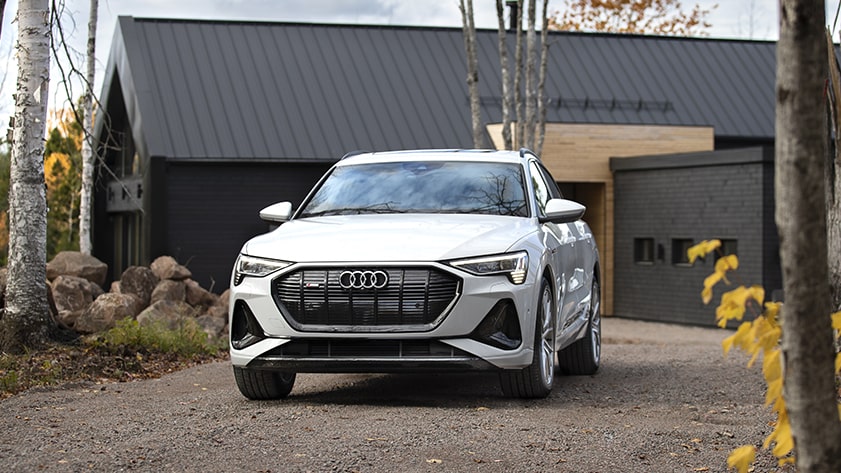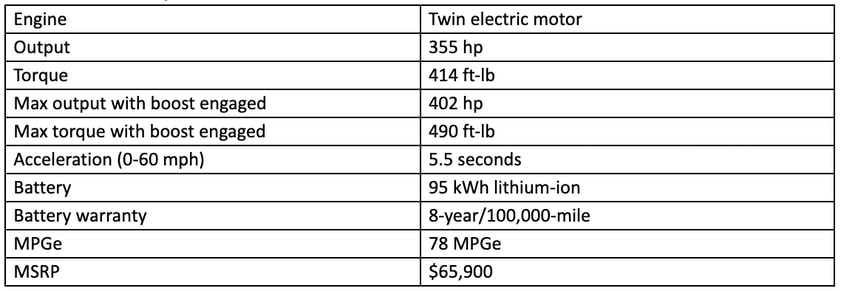How to Charge the Audi e-tron

The e-tron is Audi’s first-ever fully electric SUV, drawing on the auto manufacturer’s legacy of German engineering, performance, and luxury. The e-tron family kicked off in 2009 with a series of hybrid and concept vehicles. Now, the portfolio is growing quickly, with vehicles of varying body styles, battery sizes, and specifications—and industry-leading, fast charging at 480 volts that can take only 30 minutes to reach 80% capacity. Here’s a closer look at this premium EV and how to charge the Audi e-tron.
Audi e-tron Performance
The Audi e-tron offers long-range capabilities that increase with every new model. The EPA-rated driving range for a standard 2021 Audi e-tron runs 222 miles thanks to a 95.0 kilowatt-hour (kWh) lithium-ion battery. The e-tron features Quattro all-wheel drive powered by twin electric motors that produce 355 horsepower and 414 foot-pounds of torque. You can get a bit more power in Sport mode to boost your ride to 402 horses, and 490 foot-pounds—but using it reduces range.
2021 Audi e-tron Specs

Audi e-tron Versatile Charging Port
The Audi e-tron charging time is speedier than most, with a rate of up to 11 kW from a Level 2 (240 volt) charger and 155 kW from a DC fast charger (480 volt). The Audi e-tron uses the Combined Charging Standard (CCS), a port that handles both AC and DC connectors. The top of the CCS connector is for the Level 1 or 2 charging most often done at home, and the bottom handles DC fast charging.
Audi e-tron Charging at Home
The Audi e-tron comes with an in-home charging kit perfect for those who can install a charging solution like the Enel X JuiceBox at their residence. But beware: Level 1 charging, which uses a standard 120-volt outlet, can take 80 to 90 hours for a full charge. The slow rate is fine if you’re just topping off, but not ideal if you’ve drained the battery.
A better option is a Level 2 charging station like the Enel X JuiceBox, which can charge up to nine times faster than Level 1 charging and is a perfect option for e-tron’s standard 11 kW Type 2 AC charger. The JuiceBox provides ample cable length and an easy setup in your garage, in addition to WiFi connectivity and app functionality to help you schedule your charging when rates are low and charge with the cleanest energy on the grid.
Audi e-tron Charging at Work
Doing most of your Audi e-tron charging at work is a great option if your employer provides EV charging stations. If not, you may want to suggest they install EV charging as a perk for employees, an enticement for Gen Z or Millennial recruits, and a way to reduce business vehicle emissions. Federal and state governments and local utilities offer a combination of rebates and tax credits that can make the cost of installing a charging station extremely low.
Audio e-tron Charging on the Go
According to the Department of Energy, the United States currently has more than 47,000 public charging stations and about 5,000 that offer DC fast charging. There are a variety of apps and services available to help you find a public charger near you. Among the most prominent is PlugShare, a community-based tool available for iOS, Apple Watch, Android, and web browsers.
How to Charge While Saving the Battery
The Audi e-tron charging port is located on the driver’s side front fender, just under the e-tron logo. After you’ve parked, powered down, and set the parking brake, you charge by pushing the button to the right of the e-tron logo and plugging in the e-tron charging cable. Charging starts immediately if you haven’t chosen to postpone it. The light glows white when communicating with the charger station and pulses green when charging. You’ll see a similar indicator pulse in the instrument cluster, which shows how much charge you have, how many miles you can go, and how long charging will take. If you have a JuiceBox with smart charging capabilities, you can monitor your charge, set schedules, and get charging notifications. To protect the battery, you should charge to 80% capacity for normal commuting and to 100% only for longer journeys. You can limit or change the charging capacity using the instrument cluster. By using intelligent charging strategies, you’ll extend the battery’s life.
The Cost to Charge an Audi e-tron
Calculating how much it will cost to charge the Audi e-tron every month is straightforward. Start by checking your electric bill to find the cost per kilowatt-hour (kWh) you pay. According to the Energy Information Administration, the average residential cost for a kWh of electricity was 13.85 cents in June 2021.
According to the Kelley Blue Book, a conservative estimate of mileage per kWh is 3 to 4 miles. Let’s assume you put 1,200 miles per month on your Audi e-tron.
1200 miles / 3 or 4 miles/kWh = 300 or 400 kWh per month
300 or 400 kWh x 13.85 cents/kWh = $41.55 to $55.40 per month
Even at the highest electric rates in the country—32.74 cents per kWh in Hawaii or more than double the average electrical cost—you’re paying far less than it would cost to drive a gasoline-powered vehicle 1,200 miles at the average cost of $3.157 per gallon, also according to the EIA. The average fuel economy of new light-duty vehicles is 25.7 mpg—which would work out to about 47 gallons or $148.38 per month.
Exactly when the EV uses power to charge at home is flexible. With its WiFi connectivity and app, the Enel X JuiceBox lets you charge at the time when electricity will cost you the least, and when the utility can supply the cleanest energy. What matters for consumers and utilities alike—and especially for EV drivers—is to use energy resources wisely.







